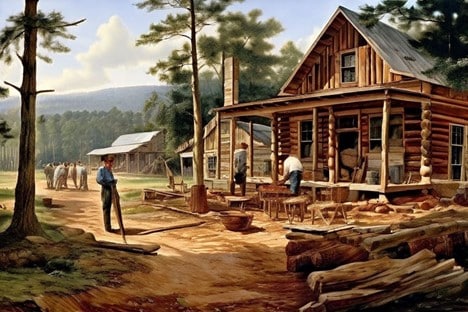Bringing History to Life: Incorporating Historical Context Into Your Family History Book
August 9, 2024
Family history books are more than a collection of dates and names; they are the stories of your ancestors and the times they lived in.
Adding historical context to your family history book not only enriches the narrative but also provides a deeper understanding of the events and circumstances that shaped your ancestors’ lives.
Here are eight ways you can effectively incorporate historical context into your family history book.
1. Start with Thorough Research
To provide an accurate historical backdrop, begin with comprehensive research. Explore local, national, and global events during the periods your ancestors lived. Look into:
- Political Events: Wars, revolutions, and political changes can significantly affect lives. If your ancestors lived through significant events like the Civil War, the World Wars, or the Great Depression, explore how these events impacted them.
- Social Changes: Movements for civil rights, women’s suffrage, or social reforms often influence personal histories. Understanding these can provide insight into your ancestors’ experiences.
- Technological Advancements: The Industrial Revolution, the advent of electricity, or the invention of the automobile might have transformed your ancestors’ daily lives and professions.
- Cultural Shifts: Changes in fashion, entertainment, and cultural norms can help paint a vivid picture of the times.
Although researching historical context for a family history book can seem daunting, there are numerous resources and strategies that can make the process both enjoyable and rewarding.

Start by exploring online archives and databases, which offer a wealth of information on historical events, social changes, and local histories.
Resources like Ancestry.com, FamilySearch.org, and the National Archives provide access to census records, military records, immigration documents, and more.
These sources can help you pinpoint significant events and trends that coincided with your ancestors’ lives.
Local libraries and historical societies are also invaluable resources for uncovering regional history.
Many libraries have special collections that include newspapers, city directories, and personal papers that aren’t available online. Visiting these institutions or exploring their digital collections can provide a deeper understanding of the local context.
Additionally, interviewing older family members can yield personal stories and insights that connect to larger historical events. These oral histories can offer unique perspectives and enrich the narrative of your family history book.
By combining these various research methods, you can create a vivid and comprehensive backdrop that brings your ancestors’ stories to life.
2. Use Primary Sources
Using primary sources is a powerful way to add depth and authenticity to the historical context of your family history book.
Primary sources, such as letters, diaries, photographs, and official documents, provide firsthand accounts and direct evidence of the past. They offer personal insights and details that secondary sources often lack.
For example, a diary entry from an ancestor can reveal facts about their daily life, thoughts, and emotions, providing a unique glimpse into their world. Similarly, letters exchanged during significant events, like wars or migrations, can shed light on how these events impacted your family personally.
Incorporating primary sources into your family history book involves more than just including excerpts or images; it requires careful interpretation and contextualization.
When you find a letter from an ancestor, consider the historical context in which it was written. What were the major world events happening at that time? How might those events have influenced the content and tone of the letter?
By answering these questions, you can weave historical context into your narrative, making the stories more engaging and meaningful. Additionally, primary sources can help verify facts and fill in gaps in your family history, ensuring a more accurate and compelling account of your ancestors’ lives.
3. Add Visual Elements
Adding visual elements to your family history book can significantly enhance its appeal and provide a richer, more immersive experience for readers.
Photographs, maps, and documents such as birth certificates, marriage licenses, and letters can help bring the narrative to life. These visuals offer tangible connections to the past, making the stories more vivid and relatable.
For instance, including a photograph of your great-grandparents’ wedding day or a map showing their migration route from Pennsylvania to Colorado can help readers visualize their journey and understand the historical context in a more concrete way.
When incorporating visual elements, it’s important to provide captions and explanations that link these images to the broader narrative.
A photo of an ancestor in military uniform, for example, can be accompanied by a brief description of their service during a particular war, including any notable battles they participated in, injuries they sustained, or the impact of their service on the family.
Similarly, documents can be placed within the context of the story, such as a baptismal certificate that not only marks a significant family event but also reflects societal norms and religious practices of the time.
By thoughtfully integrating visual elements, you not only enhance the storytelling but also create a more engaging and informative family history book.
4. Personalize Historical Events
Personalizing historical events in your family history book involves illustrating how these larger events impacted your ancestors’ lives.
Instead of merely stating that an ancestor lived during the Great Depression, delve into how this economic crisis affected their day-to-day life.
Share personal stories of their struggles and resilience, such as how they lost their job or home, and the creative ways they found to make ends meet.

Did they grow their own food, barter services, or move in with relatives? By providing these personal details, you can make the historical event more relatable and tangible for readers.
Additionally, connect major historical events to significant moments in your ancestors’ lives. For example, if an ancestor emigrated during a time of political upheaval, explain how these events influenced their decision to leave and their experiences in their new country.
Did World War II lead to your family members serving in the military or working in war-related industries? How did the Civil Rights Movement affect your family’s social and economic opportunities?
By linking these broader historical events to personal stories and decisions, you can humanize history and provide a deeper understanding of how these events shaped your family’s journey.
This approach not only enriches your narrative but also helps readers personally and emotionally connect with the past. By maintaining a balance between historical facts and personal stories, you create a compelling and cohesive family history that resonates on both an individual and historical level.
5. Include Local History
Including local history in your family history book can provide a rich backdrop that enhances your ancestors’ stories and situates them within a specific cultural and historical context.
Start by researching the history of the towns and cities where your ancestors lived. Explore local events, industries, and notable figures that may have influenced their lives.
Local libraries, historical societies, and online archives are excellent resources for uncovering this information. For example, if your family lived in a small farming community, you might include information about the agricultural practices of the time, significant crop failures, or local fairs and markets that played a role in their daily lives.
Incorporating local history can also highlight how your ancestors interacted with their community and contributed to its development.
Look for stories about their involvement in local organizations, churches, schools, or businesses.
Did your ancestors participate in community events, hold public office, or help establish local institutions? By weaving these local historical details into your narrative, you create a more vivid and dynamic portrayal of your ancestors’ lives.
Including local history not only makes their stories more engaging but also helps readers understand the broader context of their environment and the impact of local events on their personal experiences.
6. Contextualize Everyday Life
Contextualizing everyday life in your family history book brings your ancestors’ stories to life by painting a vivid picture of what daily life looked like for them.
Start by researching the common occupations, household chores, and social norms of the era in which they lived. Describe what a typical day might have looked like, from morning routines to evening activities.

For example, if your ancestors were farmers in the early 1900s, detail their daily tasks such as milking cows, tending crops, and preserving food.
Highlight the tools and techniques they used, the challenges they faced, and the seasonal rhythms that governed their lives.
Beyond work, consider the cultural and social aspects of everyday life. What kind of clothing did your ancestors wear? What foods did they eat, and how did they prepare them? Describe their homes, furniture, and the general living conditions. Delve into their leisure activities, such as the books they read, the games they played, and the music they enjoyed.
By incorporating these elements, you provide readers with a tangible sense of your ancestors’ world. This level of detail not only makes your family history more interesting but also helps readers connect with the past on a personal level, understanding not just who your ancestors were, but how they lived.
7. Balance Facts With Storytelling
Balancing truth with storytelling in your family history book is crucial for creating an engaging yet accurate narrative.
Start by grounding your story in verified facts, using documents such as birth certificates, marriage records, census data, family bibles, and personal letters to build a factual framework. This ensures that the foundational elements of your story are accurate and credible.
Whenever possible, cross-reference information from multiple sources to confirm its validity. Acknowledge any uncertainties or gaps in the historical record and be transparent about where you’ve had to make educated guesses, take creative liberties, or rely on family lore.
While maintaining factual accuracy, use storytelling techniques to bring your ancestors’ experiences to life. Employ vivid descriptions, dialogue, and sensory details to recreate scenes and evoke emotions.
For example, rather than simply stating that an ancestor immigrated, describe the journey: the sights, sounds, and feelings as they left their homeland and arrived in a new country. Use narrative arcs to build suspense and highlight significant moments, while staying true to the documented events.
Strive for a balance where the storytelling enhances the factual account, making it more engaging without distorting the truth. By doing so, you create a compelling and authentic family history that honors your ancestors and captivates your readers.
8. Consult Experts
Don’t hesitate to consult historians, genealogists, or other experts if you’re delving into complex historical periods.
They can provide insights and help ensure your historical context is accurate and well-presented.
Consulting experts can greatly enhance the accuracy and depth of your family history book.
These professionals offer specialized knowledge and access to resources that can uncover hidden details and verify facts.

Genealogists can help trace lineage, decipher old records, and navigate complex family trees, ensuring your ancestral connections are accurate.
Historians can provide broader context about the times and places where your ancestors lived, adding richness to their stories.
Engaging with experts can also help interpret historical documents, provide insights into specific cultural or regional histories, and suggest additional sources of information. By leveraging the expertise of these professionals, you can create a more comprehensive and credible family history that honors your ancestors’ lives with greater authenticity and detail.
Conclusion
Incorporating historical context into your family history book transforms it from a simple genealogical record into a rich, engaging narrative. It connects your family’s story to the broader human experience, offering readers a glimpse into the past and a deeper understanding of their heritage.
By blending personal stories with historical events, you can create a family history book that is both informative and captivating, a true testament to your ancestors’ lives and times.
Writing a family history book enriched with historical context not only honors your ancestors but also provides a meaningful legacy for future generations. It’s a journey worth undertaking, and one that will deepen your appreciation for the past and its influence on the present.































